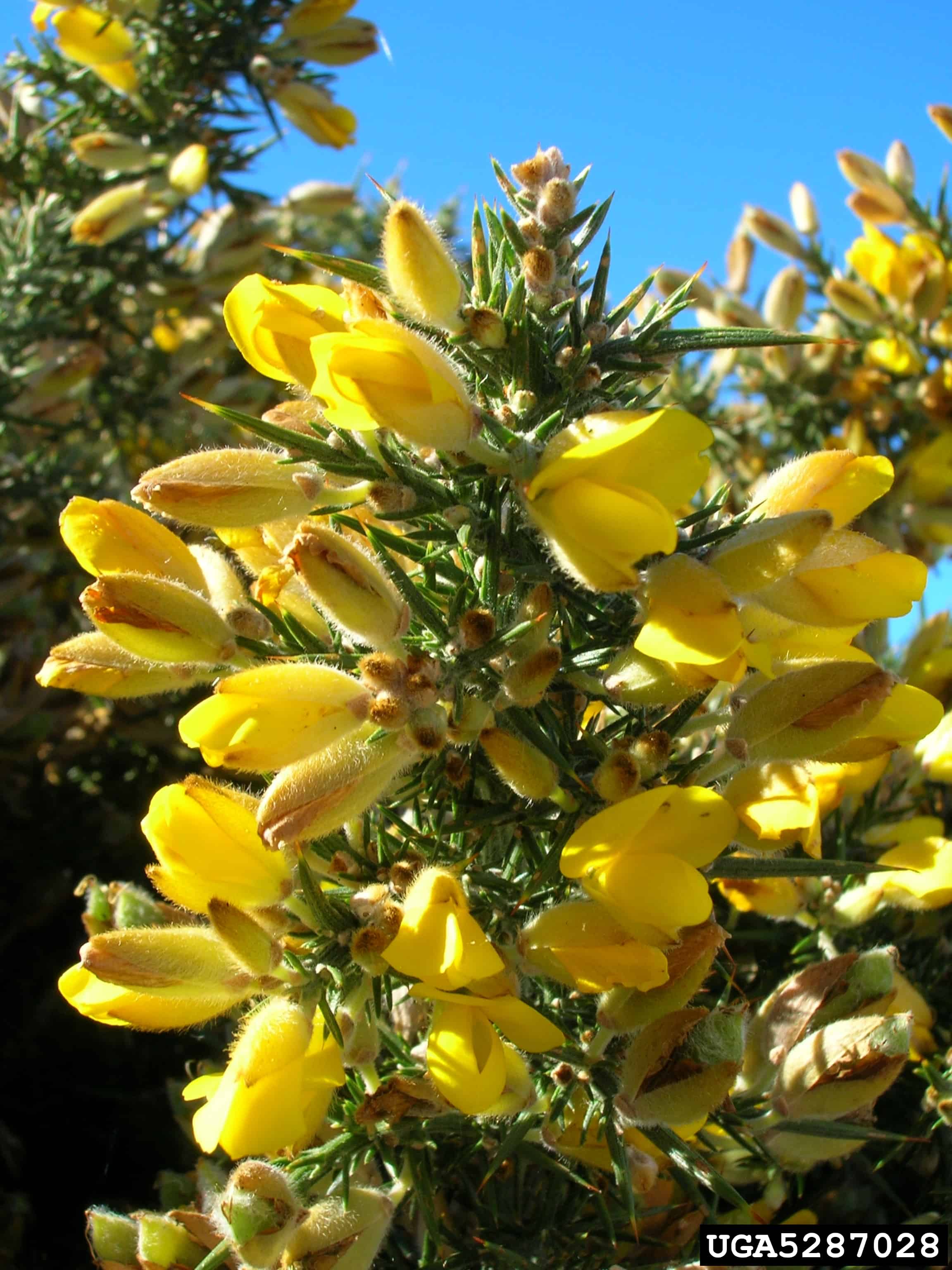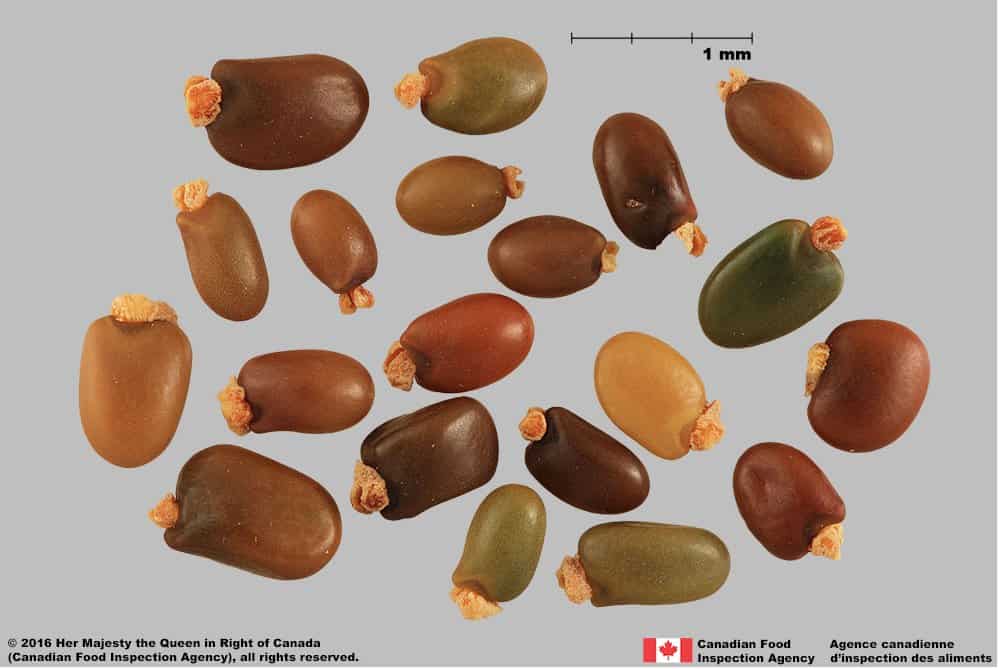Ulex europaeus
Explore More :
Explore plus :
Overview
Aperçu
Regulation :
Remarques Réglementation:
- Quarantine lists of countries e.g. Mexico *may be updated without notice
Regulation Notes:
On quarantine lists of countries e.g. Mexico*.
*Quarantine lists of countries may be updated without notice.
Distribution :
Répartition :
This species is native to Europe, introduced to southern Africa, temperate and tropical Asia, Australia, New Zealand as well as North and South America (USDA-ARS 2017). In the United States, it is most common in west coastal states but also occurs in some eastern states (USDA-NRCS 2017).
Habitat and Crop Association :
Habitat et Cultures Associées :
This species grows in sand dunes, old fields, coastal bluffs, over-grazed pastures, roadsides, rocky clearings, logged areas and burnt-over forests, preferring acidic soils (Douglas et al. 1999; Clements et al. 2001).
Economic Use, cultivation area, and Weed Association :
Utilisation économique, zone de culture et association de mauvaises herbes :
Duration of Life Cycle :
Durée du cycle vital:
Perennial
Dispersal Unit Type :
Type d’unité de dispersion :
Seed
General Information
RENSEIGNEMENTS GÉNÉRAUX
Gorse was introduced to North America as an ornamental shrub and for erosion control. It occurs primarily in coastal regions and prefers well drained, highly disturbed areas (Clements et al. 2001).
.
Ulex europaeus plants (Forest and Kim Starr, Starr Environmental, Bugwood.org)
Identification
Identification
-
Seed
Size
- Seed length: 2.7 – 3.3 mm (average 2.9 mm); width: 2.0 – 2.6 mm (average 2.3 mm); thickness: 1.3 – 2.0 mm
Shape
- Seed is oval, rounded triangular, egg-shaped or heart-shaped, compressed; sides may be concave
Surface Texture
- Seed surface is smooth
Colour
- Seed is slightly shiny, dark brown when mature; immature seeds are lighter brown
- The tissue covering the hilum is white
Other Features
- Hilum is in a prominent notch at one end of the seed covered with a knot of white tissue
- The hilum-associated tissue is persistent and is not easily removed

Ulex europaeus seeds




Identification Tips
CONSEILS POUR L’IDENTIFICATION
Additional Botany Information
AUTRES RENSEIGNEMENTS BOTANIQUES

Ulex europaeus flowers (Forest and Kim Starr, Starr Environmental, Bugwood.org)




Similar Species
ESPÈCES SEMBLABLES
Similar species are based on a study of seed morphology of various species, and those with similar dispersal units are identified. The study is limited by physical specimen and literature availability at the time of examination, and possibly impacted by the subjectivity of the authors based on their knowledge and experience. Providing similar species information for seed identification is to make users aware of similarities that could possibly result in misidentification.
Cytisus scoparius (scotch broom)
Scotch broom seeds are a similar compressed shape with a knot of tissue at one end of the seed as gorse seeds.
Scotch broom seeds are generally more oval-shaped, smaller (average length: 2.2 mm; average width: 1.5 mm), and yellow, light greenish- or reddish-brown coloured. The hilum area is flat or slightly notched with a knot of tissue that is brown-coloured.
Click to select species
Cliquez pour sélectionner les espèces

Cytisus scoparius
Comparison Window
Fenêtre de comparaison
MAIN SPECIES
ESPÈCES PRINCIPALES
Ulex europaeus

Ulex europaeus
Fabaceae
Ulex europaeus seeds
MAIN SPECIES
ESPÈCES PRINCIPALES
Ulex europaeus

Ulex europaeus
Fabaceae
Ulex europaeus seeds
MAIN SPECIES
ESPÈCES PRINCIPALES
Ulex europaeus

Ulex europaeus
Fabaceae
Ulex europaeus seed
MAIN SPECIES
ESPÈCES PRINCIPALES
Ulex europaeus

Ulex europaeus
Fabaceae
Ulex europaeus seed
SIMILAR SPECIES
ESPÈCES SEMBLABLES
Cytisus scoparius

Cytisus scoparius
Fabaceae
Cytisus scoparius seeds
SIMILAR SPECIES
ESPÈCES SEMBLABLES
Cytisus scoparius

Cytisus scoparius
Fabaceae
Cytisus scoparius seeds
SIMILAR SPECIES
ESPÈCES SEMBLABLES
Cytisus scoparius

Cytisus scoparius
Fabaceae
Cytisus scoparius seed
Need ID Help?
Besoin d’aide pour l’identification?
Reference(s)
Référence(s)
Clements, D.R., Peterson, D.J. and Prasad, R. 2001. The biology of canadian weeds. 112. Ulex europeaus L. Canadian Journal of Plant Science 81:325-337.
Douglas, G.W., Meidinger, D. and Pojar, J., (eds.) 1999. Illustrated Flora of British Columbia, Volume 4: Dicotyledons (Diapensiaceae through Onagraceae). B.C. Ministry of Environment, Lands and Parks and Ministry of Forests, Victoria, BC. 427 pp.
Global Biodiversity Information Facility (GBIF) Secretariat. 2022. https://doi.org/10.15468/39omei Accessed via https://www.gbif.org/species/2951984 Accessed December 29, 2022.
U.S. Department of Agriculture-Agricultural Research Services (USDA-ARS). 2017. Germplasm Resources Information Network (GRIN), https://npgsweb.ars-grin.gov/gringlobal/taxon/taxonomysearch Accessed April 25, 2017.
U.S. Department of Agriculture-Natural Resources Conservation Service (USDA-NRCS). 2017. The PLANTS Database. National Plant Data Team, Greensboro, NC USA. https://plants.usda.gov/home Accessed April 25, 2017.
U.S. Department of Agriculture-Natural Resources Conservation Service (USDA-NRCS). 2022. The PLANTS Database. National Plant Data Team, Greensboro, NC USA. http://plants.usda.gov Accessed December 29, 2022.




